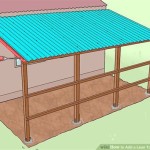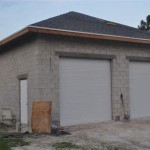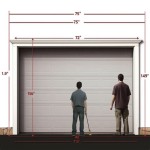Can You Put a Dryer Vent in the Garage Ceiling of a House?
The question of whether a dryer vent can be installed in a garage ceiling is a complex one, involving building codes, safety considerations, and practical limitations. While it might seem like a convenient solution, especially if the home's layout presents challenges for traditional venting, the feasibility and legality of such an installation depend on several factors. Thorough evaluation and compliance with local regulations are crucial before undertaking such a project.
Garage environments pose unique challenges due to the presence of flammable materials, the potential for carbon monoxide build-up from vehicles, and the frequent presence of fire-rated walls. Therefore, diverting dryer exhaust into the garage requires careful consideration and adherence to stringent safety protocols to prevent fire hazards, carbon monoxide poisoning, and other potential dangers.
Building codes regarding dryer vent installations are designed to ensure the safe and efficient removal of lint and moisture. These codes vary by jurisdiction, but they typically specify the type of material required for vent ducts, the maximum length of the vent run, and the allowable number of bends. Deviating from these codes can lead to serious consequences, including fines and required remediation work.
Key Point 1: Understanding Potential Hazards and Code Requirements
One of the primary concerns when venting a dryer into a garage ceiling is the accumulation of lint. Dryer lint is highly flammable and can ignite easily, especially in the presence of heat or sparks. Traditional dryer vents carry hot, moist air laden with lint, which can accumulate in the vent duct and create a significant fire hazard. In a garage, where flammable liquids like gasoline and oil are often stored, the risk of a fire is amplified.
Building codes typically require dryer vents to terminate outside the building to prevent the build-up of lint and moisture indoors. This is because excessive moisture can lead to mold growth, which can negatively impact indoor air quality and structural integrity. Venting into a garage, which is often attached to the house, can effectively introduce moisture into the living space, especially if the garage is not properly ventilated.
Furthermore, the International Residential Code (IRC), a widely adopted model building code, provides specific guidelines for dryer exhaust systems. These guidelines address the type of duct material that must be used (typically rigid metal), the maximum length of the duct run (often limited to 25 feet with deductions for bends), and the required clearances around the vent termination. Many local jurisdictions adopt or adapt the IRC, so understanding these requirements is essential.
When considering a garage ceiling installation, it is imperative to consult with local building officials to determine the specific code requirements in the area. A building permit may be required for the installation, and an inspection may be necessary to ensure compliance with the code. Failing to obtain the necessary permits or failing to meet the code requirements can result in fines and the need to redo the installation.
Key Point 2: Exploring Alternative Venting Options
Given the potential challenges and hazards associated with venting a dryer into a garage ceiling, it is prudent to explore alternative venting options. These alternatives may offer a safer and more code-compliant solution for venting the dryer.
One such alternative is to vent the dryer directly outside through a wall. This is the most common and generally the most recommended method for venting a dryer. It involves running the vent duct directly from the dryer to an exterior wall and terminating the vent with a proper exhaust hood. This method ensures that lint and moisture are expelled outside the building, minimizing the risk of fire and mold growth.
Another option is to use a longer vent run to reach an exterior wall that is further away from the dryer. While this may require more ductwork, it can be a viable solution if the dryer is not located near an exterior wall. However, it is important to keep in mind the maximum allowable vent length specified by the building code. Excessive vent length can reduce the efficiency of the dryer and increase the risk of lint build-up.
A third possibility is to consider using a ventless dryer. Ventless dryers use a condensation or heat pump system to dry clothes without the need for an external vent. These dryers can be installed virtually anywhere, as they do not exhaust air. While ventless dryers may be more expensive than traditional vented dryers, they can be a good option for homes where venting is difficult or impossible.
Before committing to a garage ceiling installation, homeowners should carefully evaluate all available venting options and choose the one that best balances safety, cost, and convenience. Consulting with a qualified HVAC professional or a building inspector can help determine the most appropriate venting solution for a particular situation.
Key Point 3: Addressing Practical Considerations and Mitigation Strategies
If, after carefully considering all other options, a dryer vent in the garage ceiling appears to be the only feasible solution, then certain practical considerations and mitigation strategies must be addressed to minimize the risks and ensure the safety of the installation.
First and foremost, the vent duct must be constructed of rigid metal. Flexible foil or plastic ducts are not permitted by most building codes, as they are more prone to lint accumulation and can collapse, restricting airflow. Rigid metal ducts provide a smoother surface for airflow and are less likely to trap lint.
Second, the vent duct should be as short and straight as possible. Every bend in the duct reduces airflow and increases the risk of lint build-up. If bends are unavoidable, they should be gradual and smooth, rather than sharp and abrupt. The number of bends should be kept to a minimum.
Third, the vent duct should be properly insulated to prevent condensation. When warm, moist air from the dryer travels through a cold duct, condensation can form, which can lead to mold growth and corrosion. Insulating the vent duct can help prevent condensation and maintain the integrity of the ductwork.
Fourth, a lint trap or lint filter should be installed in the vent duct to capture any lint that bypasses the dryer's internal lint screen. This can help reduce the amount of lint that accumulates in the duct and minimize the risk of fire.
Fifth, the dryer vent should be regularly inspected and cleaned to remove any accumulated lint. This is an essential maintenance task that should be performed at least once a year, or more frequently if the dryer is used heavily. Professional dryer vent cleaning services are available to ensure that the vent is thoroughly cleaned.
Finally, a carbon monoxide detector should be installed in the garage to alert occupants in the event of a carbon monoxide leak. While a dryer vent in the garage ceiling does not directly create carbon monoxide, it is important to have a carbon monoxide detector in place as a general safety precaution, especially if vehicles are parked in the garage.
In summary, while it may be technically possible to put a dryer vent in the garage ceiling of a house, it is a practice that requires careful consideration and adherence to strict safety protocols. Understanding potential hazards, exploring alternative venting options, and implementing appropriate mitigation strategies are all essential steps in ensuring a safe and code-compliant installation. Consulting with qualified professionals, such as HVAC technicians and building inspectors, is strongly recommended. The final decision should prioritize the safety and well-being of the occupants of the home.

How To Install A Dryer Vent The Home Depot

How To Install A Dryer Vent The Home Depot

Atypical And Typical Dryer Vent Locations The Right Spots
The Exhaust Of My Dryer Vents To Crawl Space House Is That Correct Should I Change It Or Leave As Appaly Has Always Been Like
Can An Electric Dryer Be Vented Into A Garage Quora

Dryer Vent Installation And Upgrades Diy

How To Install A Dryer Vent The Home Depot

When Dryer Vents Need A Boost Fine Homebuilding

What You Should Know About Roof Dryer Vents
Mini Split In Garage That Has A Vent Bogleheads Org
Related Posts








